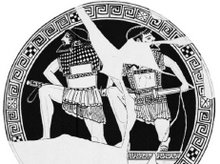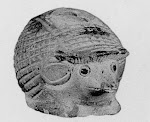http://www.mcfarlandbooks.com/book-2.php?id=978-1-4766-6602-0
I have held off on posting anything that would wide up in the book, but now that it is on the way I will be uploading a series of videos here and on this blog's sister Facebook site and YouTube channel:
https://www.facebook.com/groups/206586183088885/
https://www.youtube.com/channel/UC8uaDxWxD_MmN3TeEcdc5IA






5 comments:
Excellent and congratulations.
Thanks! I am excited. Whether we are right or wrong in our conclusions I will leave for others to decide,but at least we offer a fresh perspective and context that might just reconcile the various sides in the hoplite debate.
I look forward to reading it, especially as a challenge to conclusions reached in "Storm of Spears". Don't get me wrong, I love that book and have read it twice through. However, even as a lay reader, I was troubled by Matthew's dismissal of existing data on overarm strikes. I was not convinced by his assumptions that they must be from a thrown weapon; and he didn't seem that convinced either.
I followed your criticisms of Matthew's research (you quote Ray's analysis of the artwork statistics for example); and I caught up with your JaMming session on the Ancient Warfare forums. However, it is the "gybing" videos that really increased my skepticism of Matthew's devaluing of overarm weapon play -- I witnessed prolonged, strong strikes from an overhead position.
Frankly, Matthew's portrayal of the overarm strike now strikes me as almost comical, e.g. the extreme arching downwards as if you're planting a pole in a hole. I am aware your approach is slightly different from "gybing" but provides the same power using the weight of the spear (I think). Combined with Matthew's defensive tone, it doesn't look good.
Anyway; we're being spoiled. We'll soon have two detailed examinations of hoplite mechanics on our bookshelves. Mana from heaven.
I think you will be pleased. Many of us told Chris he was barking up the wrong tree before he started his Ph.D., but it is a bit sad that what he produced is so mistaken and misleading. I have been such a huge advocate of reenactment as experimental archaeology that I both felt bad having to correct the one product of such experimentation to have come out and disappointed is the poor conclusions he reached. Leave aside that his analysis of vase images is flawed, the two big problems that I address in the book are that the overhand strike he used in testing is obviously done wrong, and he never shows hoplites in 45cm frontages (you can't do it with a 90cm aspis). His whole thesis hinges on underhand use at 45cm frontage- both of which are Hellenistic and anachronistic for hoplites.
My strike is identical to the overhand gig, except it is not released. The releasing of the spear does not really do anything for you when the spear is gripped near the rear as I believe they were in the classical period. The shape of the spear is one of the things Mathew got right.
Post a Comment